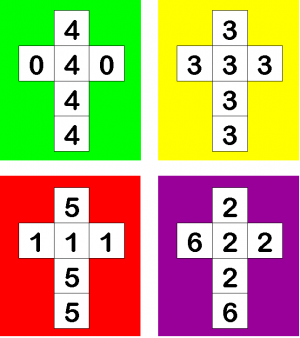Playing with Probability - Efron's Dice
Lesson idea. A lesson activity to explore probability with dice. We are used to the idea of transitivity, where we can ascribe an order to events. Efron’s dice are non-transitive and probability methods that the pupils are familiar with can be used to explore how to play a game using them.
Teaching approach. Efron's dice provide a discussion(ta) topic for joint reasoning(ta) - whole class(ta) or in group work(ta). Pupils can explore aspects of mathematical thinking(ta) particularly with relation to probability. (edit)
| Resource details | |
| Title | Playing with Probability - Efron's Dice |
| Topic | [[Topics/Probability|Probability]] |
| Teaching approach | [[Teaching Approaches/Whole class|Whole class]], [[Teaching Approaches/Mathematical thinking|Mathematical thinking]], [[Teaching Approaches/Group work|Group work]], [[Teaching Approaches/Reasoning|Reasoning]], [[Teaching Approaches/Discussion|Discussion]] |
| Learning Objectives | Understanding the worth of probability tables and how to use them to solve a problem. |
| Format / structure | A wiki page also available as a downloadable Word document. |
| Subject | [[Resources/Maths|Maths]] |
| Age of students / grade | [[Resources/Secondary|Secondary]], [[Resources/KS4|KS4]], [[Resources/KS3|KS3]]
|
| Useful information | Large wooden dice that are coloured green, yellow, red and purple with stickers to show numbers (see this page).
|
| Files and resources to view and download | Playing with Probability - Efrons Dice/Activity and as a download File:Efron's Dice Activity.doc. |
| Acknowledgement | This resource was adapted from resources contributed by Mark Dawes |

